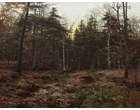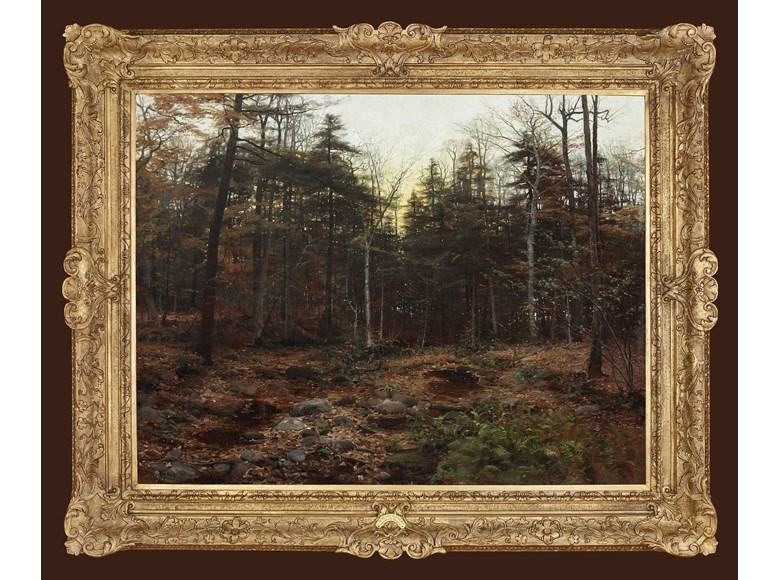 BACK TO GALLERY
BACK TO GALLERY
Avery Galleries
William Bliss Baker
Woodland Scene
Signed and dated lower left: W Bliss Baker 1885
38 x 50 inches (96.5 x 127 cm)
description
A gifted landscape artist, the artistic potential of William Bliss Baker was cut short with his untimely death in 1886. Due to the unforeseen end to his career, Baker was able to create only a limited number of Tonalist landscapes, making them exceedingly rare.
William Bliss Baker was born in New York City in 1859 and was raised upstate in the village of Ballston Springs. Baker’s early penchant for painting steered him to enroll in classes at the National Academy of Design when he was only seventeen years old. His passion and ambition were not without warrant: The National Academy awarded Baker’s skill in 1879 with the Elliot prize for drawing, and again in 1885 when he was the recipient of one of the prestigious Julius Hallgarten prizes.
The Salmagundi Sketch Club invited Baker to exhibit his works beginning in 1881 at The Black and White Exhibitions, and the artist continued to do so for the next five years, with the exception of 1885.[1] Justified by the strict acceptance of works done only in black and white, these exhibitions provided the opportunity for Baker’s works to hang alongside the likes of William Merritt Chase, Winslow Homer, the Moran brothers, John Singer Sargent, and James M. Whistler, to name a few.
The rapid progression of his success can be credited to his sensational landscapes: “He possessed, in an eminent degree, the very uncommon ability to elaborate detail and to render minute and subtle effects with close finish, while yet preserving in his pictures the breadth and dignity of the largest facts.”[2] In 1886, Baker’s career tragically ended just as he was reaching the pinnacle of his success. At the young age of twenty-seven, Baker succumbed to health complications stemming from a reported skating accident that occurred while visiting his artist studio in New York.
After his death, one hundred and thirty of Baker’s paintings were put up for auction, and the sale brought in almost $15,000. Critics considered this amount quite a feat, given Baker’s youth and that he was a fully American-trained artist.
[1] Alexander W. Katlan, The Black and White Exhibitions of the Salmagundi Sketch Club 1878 to 1887 (New York 2007): 49.
[2] Catalogue of the Private Art Collection of Thomas B. Clarke (New York: American Art Association, 1899), 18.
[3] “Selling Works of Art: Pictures of Baker, Sprague’s Collection, and the Baker Statues” in The New York Times (18 March 1887): 5.
William Bliss Baker was born in New York City in 1859 and was raised upstate in the village of Ballston Springs. Baker’s early penchant for painting steered him to enroll in classes at the National Academy of Design when he was only seventeen years old. His passion and ambition were not without warrant: The National Academy awarded Baker’s skill in 1879 with the Elliot prize for drawing, and again in 1885 when he was the recipient of one of the prestigious Julius Hallgarten prizes.
The Salmagundi Sketch Club invited Baker to exhibit his works beginning in 1881 at The Black and White Exhibitions, and the artist continued to do so for the next five years, with the exception of 1885.[1] Justified by the strict acceptance of works done only in black and white, these exhibitions provided the opportunity for Baker’s works to hang alongside the likes of William Merritt Chase, Winslow Homer, the Moran brothers, John Singer Sargent, and James M. Whistler, to name a few.
The rapid progression of his success can be credited to his sensational landscapes: “He possessed, in an eminent degree, the very uncommon ability to elaborate detail and to render minute and subtle effects with close finish, while yet preserving in his pictures the breadth and dignity of the largest facts.”[2] In 1886, Baker’s career tragically ended just as he was reaching the pinnacle of his success. At the young age of twenty-seven, Baker succumbed to health complications stemming from a reported skating accident that occurred while visiting his artist studio in New York.
After his death, one hundred and thirty of Baker’s paintings were put up for auction, and the sale brought in almost $15,000. Critics considered this amount quite a feat, given Baker’s youth and that he was a fully American-trained artist.
[1] Alexander W. Katlan, The Black and White Exhibitions of the Salmagundi Sketch Club 1878 to 1887 (New York 2007): 49.
[2] Catalogue of the Private Art Collection of Thomas B. Clarke (New York: American Art Association, 1899), 18.
[3] “Selling Works of Art: Pictures of Baker, Sprague’s Collection, and the Baker Statues” in The New York Times (18 March 1887): 5.








 SEND AN EMAIL
SEND AN EMAIL
 (610) 896-0680
(610) 896-0680